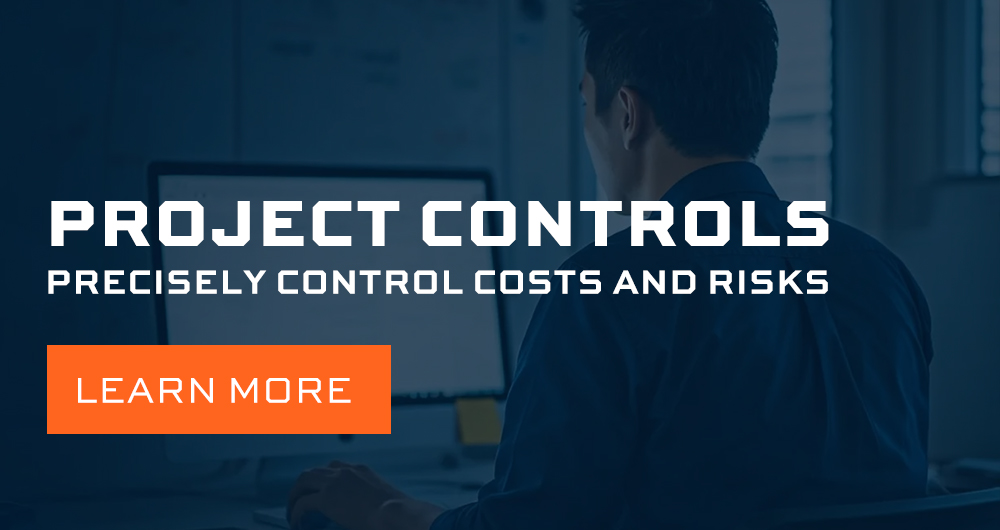Earned value management (EVM) gives capital construction project teams a clear, data-driven picture of cost and schedule performance. When combined with integrated EVM and construction analytics software, EVM becomes a proactive planning, risk management, and collaboration tool — helping teams forecast outcomes, control budgets, and deliver confidently
Understanding the Power of Earned Value Management in Construction
It’s fairly well understood that gathering and monitoring construction project data throughout the build helps prevent going over budget and falling behind schedule. What may not be as well understood is how to most effectively do this.
As a method to measure project performance, earned value management (EVM) specifically addresses construction progress in terms of how the spend and timeline work together, rather than treating them as siloed values. It answers “Where are we now and is it where we should be?” and “Where are we headed based on our present path?”
But EVM’s value goes far beyond that. More than being a mere barometer of cost and schedule progress, earned value management for capital construction— particularly when its data is captured, organized and processed through an integrated construction data analytics software — enables you to leverage insights into how to solve the challenges common among construction projects.
EVM as a Planning Tool for Capital Construction Projects
Keeping things from inching beyond set timeline milestones and budget thresholds takes skill — and data. Assuming source data from your estimate provides an accurate baseline against which to gauge progress, EVM gives you real-time visibility into your project’s performance.
So, you can know that everything is humming along within the operating ranges you set at the project’s start. Or conversely, you can spot and analyze gradually developing trends or sudden deviations in any of the data of your earned value management calculations. Knowing what these metrics are at any given moment — and what the specific values unique to each calculation mean — ensures you can identify when you need to keep an eye on a trending shift or take more urgent corrective action.
Examples of key EVM performance indicators for construction projects include:
- Schedule and Cost Variances (SV and CV): Positive values mean a project is ahead of schedule or below budget, negative values mean behind schedule or over budget, and “0” means on schedule or on budget.
- Schedule and Cost Performance (SPI, CPI):Values greater than 1 are ahead of schedule or below budget, less than 1 is behind schedule or over budget, and “0” is on schedule or on budget.
- Operating Ranges (SPI and CPI): These represent the natural high-low swings within parameters you establish at the beginning of your project. They’re what is deemed acceptable to you based on the particulars of your project. For instance, a smaller range may apply to work performed in controlled environments where fewer external factors can interfere, while projects in more variable or harsh conditions may require wider ranges to account for impacts such as severe weather.
In essence, your data gives you actionable insights. What you gain from these insights into your project metrics is certainty — regardless of whether the numbers are reassuring or cause for concern. Granted, very little is ever truly 100% certain in construction. But EVM could be as close as you get to a crystal ball. With the level of accuracy EVM affords in tracking and forecasting project performance, it allows you to better plan as circumstances evolve. Modern EVM software automates this process, providing real-time dashboards that make complex data accessible to every project stakeholder.
EVM as a Risk-Management Tool for Complex Capital Projects
Nobody likes surprises during a massive capital construction project. So perhaps the most important aspect of earned value management is its ability to serve as an alert system, essentially waving red flags when the metrics indicate something is amiss or heading in that direction.
What this alert does is enable you to identify anything impacting your ability to complete the project according to your contractual requirements. There will always be surprises that occur during a project’s life cycle but using EVM for construction risk management can at least remove project performance metrics as a contender.
Earned value management reduces risk by enabling project managers and contractors to respond in real time to current or forecasted deviations or problems, rather than after they’ve worsened. It basically hands you an opportunity to launch any of the contingency plans you developed before the project began.
This could be anything from calling on extra backup craftspeople to complete a task that is at risk of running late, reallocating funds from one below-budget portion of your project to another that is fast approaching its limit, or reflowing the schedule due to an external factor beyond your control, such as material supply shortage, to help it get back on track. Integrating earned value management into your project controls software ensures these early warning signals are visible across teams, making proactive risk mitigation easier and faster.
EVM as a Collaborative Decision-Making Tool
Much of construction project success relies on timely decisions. But how do you know you’re making the best, most informed decisions? By relying on real-time EVM data.
Field data feeds EVM’s cost, schedule and scope metrics, creating a transparent, objective view of performance. With this shared visibility, owners and contractors can collaborate more effectively, build trust, and align expectations. The transparency earned value management enables not only strengthens accountability but also helps close the knowledge gap between all project stakeholders.
When delivered through an integrated EVM platform, this visibility extends to all stakeholders, strengthening alignment and accountability.
Investing in Earned Value Management for Future-Ready Projects
Despite these capabilities that earned value management metrics deliver, these are areas that historically have been missed opportunities in the industry. But that’s changing. Owners and contractors alike now consider investing in EVM systems and data analytics technology to be critical to the success of capital projects in the future.
Of course, the data and calculations used to make earned value management such a powerful value-add tool for capital construction depend on robust technology to process it all for you and deliver the timely insights via intuitive dashboards and reports.
To stay competitive, more construction teams are adopting connected EVM and project controls software that unifies cost, schedule, and risk data into one performance view.
InEight provides connected project controls and earned value management (EVM) software that helps capital project teams plan, track, and forecast with confidence. Our integrated analytics deliver real-time visibility into cost, schedule, and risk — empowering owners and contractors to make data-driven decisions and achieve project certainty.



